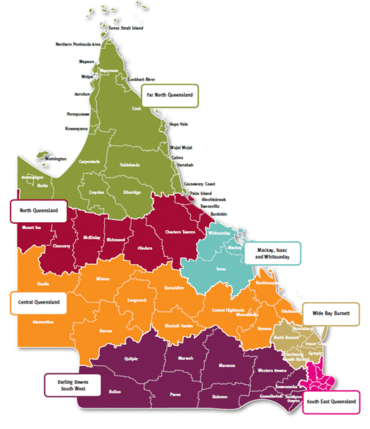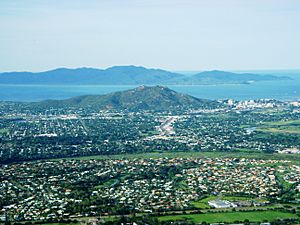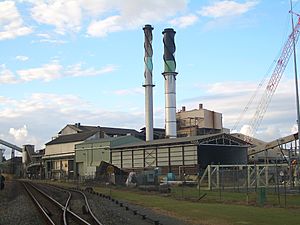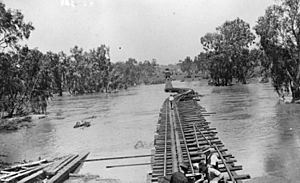North Queensland facts for kids
Quick facts for kids North QueenslandQueensland |
|
|---|---|

Queensland's regions
|
|
| Population | 231,628 (2011) |
| • Density | 2.893849/km2 (7.49503/sq mi) |
| Area | 80,041.5 km2 (30,904.2 sq mi) |
| LGA(s) |
|
| State electorate(s) |
|
| Federal Division(s) | |
North Queensland is a special part of the Australian state of Queensland. It lies just south of another area called Far North Queensland. Queensland is a huge state, bigger than many countries! Its northern part is tropical and has always been a bit remote. This has given it a unique feel and identity.
Townsville is the biggest city in North Queensland. Many people see it as the unofficial capital of the region. About 231,628 people live here. The area covers about 80,041.5 square kilometers.
Contents
Exploring North Queensland's Geography


There isn't an exact line that separates North Queensland from the rest of the state. Usually, its southern border is thought to be just south of the Mackay Region. In the past, it even stretched as far south as Rockhampton. To the north is the Far North Queensland region, which includes Cairns. To the west is the Gulf Country.
Coastal Cities and Major Ports
North Queensland is mostly a coastal area. Its biggest city is Townsville. Townsville has a very important seaport. This port helps to export minerals from mines in Mount Isa. It also ships cattle from farms along the coast and inland.
Another key port is at Lucinda. This port handles large amounts of sugar for export. The Mackay and Burdekin regions are known as Australia's "sugar capital." They produce the most sugar in the country, which is then shipped from Mackay Harbour. Mackay is also one of Australia's largest coal exporters. This is because it's close to Queensland's major coal mines. Other big coal ports include Abbot Point, north of Bowen, and Dalrymple Bay, south of Mackay.
Inland Towns and Farming Areas
The region also includes the inland city of Charters Towers. Coastal towns like Ayr and Ingham are also important. The Burdekin area is centered around the towns of Ayr and Home Hill. While it produces the most sugar, it also grows seasonal fruits. These include Lychees and Mangos during the summer wet season.
Other communities in North Queensland are Home Hill, Sarina, Bowen, Ayr, and Proserpine. Great Palm Island is home to Australia's largest separate Indigenous community. You can also find Wallaman Falls near Wallaman. It's Australia's highest permanent single-drop waterfall.
A Look at North Queensland's History
North Queensland has a rich history, including the stories of its Aboriginal people.
Aboriginal Languages and Culture
- Gugu Badhun is an Aboriginal language from North Queensland. This language is spoken in areas like Charters Towers Region, especially around Greenvale and the Valley of Lagoons. It's also found in the Upper Burdekin River area and Abergowrie.
- Warrgamay is another Aboriginal language from North Queensland. It's spoken in the Herbert River area, including Ingham, Hawkins Creek, Long Pocket, and Cardwell. It's also heard on Hinchinbrook Island and the nearby mainland.
- Yuru is an Aboriginal language spoken on Yuru country. This language region includes the land within the Shire of Burdekin, including the town of Home Hill.
Early European Exploration and Settlement
In 1770, Captain James Cook sailed past this region. He gave names to several places, such as Magnetic Island and Cape Cleveland. Allan Cunningham was the first European to explore parts of the region on land. Later, John Mackay explored the Pioneer Valley near Mackay in 1860.
The first European settlement in the region was started at Port Denison in 1861. This place is now known as Bowen. In 1865, the first surveys for what would become Townsville were done. A big change happened in 1871 when gold was found at Charters Towers. This discovery led to a lot of growth for Charters Towers and Townsville. Townsville became a major port and service center as farming and the sugar industry grew along the coast. Work on the Great Northern Railway from Townsville to Mount Isa began in 1879. A small part of the railway opened the next year.
Pacific Islander Workers
An Immigration Port was set up in Bowen in 1866. This was because Queensland's sugar farms needed many workers from the Pacific Islands. At first, workers were sometimes forced to come. Later, the trade became voluntary. Over 40 years, about 60,000 "kanakas" (Pacific Island workers) came to Queensland to work.
World War II and Cultural Growth
In July 1942, Japanese planes carried out air raids on Townsville during World War II.
After the war, the region saw cultural growth. The Perc Tucker Regional Gallery opened in Townsville in 1981. The TYTO Regional Art Gallery in Ingham opened in 2011.
In 1995, the North Queensland Cowboys rugby league team joined the Australian Rugby League competition.
Tourism and Natural Wonders
North Queensland is a fantastic place for tourists! It has many amazing attractions. These include parts of the Great Barrier Reef and its beautiful islands. You can also explore the rainforests of the Wet Tropics of Queensland. Other popular spots are Eungella, Magnetic Island, and the stunning Whitsunday Islands. The region is home to 36 national parks, offering lots of natural beauty to explore.
Transportation in North Queensland
The region is served by Townsville Airport. It's the 11th busiest airport in Australia. The airport became an international airport in 1980.
Along the coast, the Bruce Highway runs through the region from south to north. The Flinders Highway connects Townsville with Charters Towers. The Peak Downs Highway extends west from Mackay. For train travel, the Tilt Train and Spirit of Queensland services use the North Coast railway line along the coast.
Ideas for a New State of North Queensland
Over the years, many people have suggested that North Queensland should become its own state. There have been many plans drawn up. These plans discuss where the borders would be, what the new state would be called, and which town would become the capital city.



